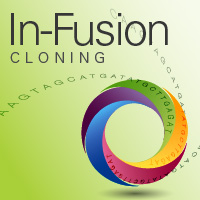Insertions, deletions, and substitutions, oh my!—designing primers for site-directed mutagenesis

Does your mutagenesis method perform poorly with GC-rich templates? Are you getting too few or too many colonies, colonies without the mutation you want, or no colonies at all? Sadly, these problems have been frustrating researchers for decades.
You’ll be happy to know that there is a solution, and it starts and ends with “In-Fusion.” In-Fusion is well-known for being the highest performing seamless cloning product on the market, but did you know that you can also use the technology for site-directed mutagenesis?
In-Fusion Cloning products provide the flexibility to generate single or multiple base changes, deletions, and insertions using any vector, with over 95% accuracy—by combining the power of In-Fusion Cloning technology with high-fidelity inverse PCR using a polymerase that works well with GC-rich templates.
What is the protocol for In-Fusion Cloning site-directed mutagenesis?
During inverse PCR with In-Fusion systems, primers are oriented in opposite directions on your circular cloning vector (Figure 1). To perform mutagenesis, design your PCR primers so that they have a 15-bp overlap with each other at their 5' ends and incorporate the mutation of interest, and use a high-fidelity PCR polymerase such as PrimeSTAR Max DNA Polymerase, which exhibits minimal error rates on GC-rich templates.

Figure 1. Procedure for performing mutagenesis with In-Fusion technology. The area where mutagenesis occurs is shown in yellow. After designing your experiment, perform the protocol (Step 3 above) on Day 1, and recover your final construct (Step 4 above) on Day 2. Note: Although all examples shown here involve protein coding (gene) sequences, you can use the same methods to modify noncoding sequences such as promoters or transcription factors.
Want the nitty-gritty details? See our Mutagenesis with In Fusion Cloning tech note!
How do I design In-Fusion primers for site-directed mutagenesis?
Our online primer design tool lets you design primers for your site-directed mutagenesis experiment simply by inputting the DNA sequences of your vector and insert(s). It allows you to specify the exact nucleotides to be deleted, add the vector sequence of your choice at your desired insertion locus, enter a replacement sequence (independent of restriction sites), and download primer and PCR information based on your design. Use our tool together with the guidelines below, noting that specialized tutorials are available for designing primers to generate deletions, insertions, and substitutions.
General guidelines for primer design
- Each PCR primer should direct DNA synthesis in the opposite orientation of the other on a circular vector template.
- The 3' ends of the forward and reverse PCR primers should have 18–25 nt that are complementary to the template, ensuring efficient and specific amplification.
- Mutations should be incorporated within the homologous 15-nt overlap located at the 5' ends of the forward and reverse PCR primers (this homologous overlap is required for the recircularization of the mutated vector).
- Single- or multiple-base changes, deletions, or insertions can be introduced in a single In‑Fusion reaction.
- A larger deletion of any desirable length can also be introduced by positioning the 3' ends of the forward and reverse primers at the border sites of a deletion, with homologous overhangs carried by the 5' end of either of the primers.
The resulting inverse PCR will generate a linear double-stranded vector with the flanking ends complementary to each other and carrying the 15-nt homologous overlap. This overlap will be joined through the In‑Fusion reaction and recovered in E. coli, thus generating a mutated vector. Vectors amplified by inverse PCR may be treated with Cloning Enhancer to destroy the parental vector and used directly in the In-Fusion reaction.
How do I delete a specific sequence from any vector?
Use the primer design tool (selecting “Mutagenesis” under “Project Type”) together with the “Deleting a sequence” tutorial to design PCR primers to:
- delete a specific base or sequence in the vector of choice
- specify the exact nucleotide(s) to be deleted
- generate and download the designed primers and PCR information
How do I insert a specific sequence into any vector?
Simply use the tool with the “Inserting a sequence” tutorial to design primers to:
- add the vector sequence of your choice
- choose the insertion locus (independent of restriction sites) and specify the exact nucleotides to be added
- download primer and PCR information based on your design
How do I delete and replace a sequence in any vector?
Once again, use the tool with the “Deleting and replacing a sequence in any vector” tutorial to design primers to:
- add the vector sequence of your choice
- specify the exact nucleotides to be deleted
- enter your replacement sequence
- download primer and PCR information based on your design
With In-Fusion for mutagenesis, you now have the courage and confidence to overcome your site-directed mutagenesis challenges, and you’ll never look back with this powerful, precise tool for faster, easier, and more accurate site-directed mutagenesis using your vector of choice.
Deleting a specific sequence from any vector
Design primers to delete nucleotides from your vector of choice at any locus.
Inserting a specific sequence in any vector
Design primers to add nucleotides, like small tags or domains, to your vector of choice at any locus.
Deleting and replacing a sequence in any vector
Design primers to simultaneously delete and replace nucleotides (e.g., for domain swapping studies) in your vector of choice at any locus.
Takara Bio USA, Inc.
United States/Canada: +1.800.662.2566 • Asia Pacific: +1.650.919.7300 • Europe: +33.(0)1.3904.6880 • Japan: +81.(0)77.565.6999
FOR RESEARCH USE ONLY. NOT FOR USE IN DIAGNOSTIC PROCEDURES. © 2025 Takara Bio Inc. All Rights Reserved. All trademarks are the property of Takara Bio Inc. or its affiliate(s) in the U.S. and/or other countries or their respective owners. Certain trademarks may not be registered in all jurisdictions. Additional product, intellectual property, and restricted use information is available at takarabio.com.









